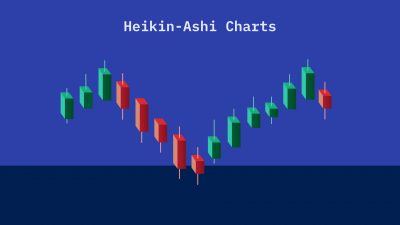

Understanding Renko Charts with another example
Renko charts represent a change in price, when the change that happens is large enough to be significant for the trader. The trader can choose to define the size of this price move (brick size) that they consider it significant enough to be represented. We have already established that the brick size is pre-determined by the trader. Let’s take one example here – if you’re trading with Renko charts, and your preferred brick size is INR 2, then bricks only form when price moves either up or down by INR 2. A green Renko brick would form only after the price would advance INR 2. After a green brick, red brick will form after the price moves by INR 4 in the opposite direction.How to decide and choose the brick size?
A lot of traders prefer average true range (ATR) as the brick size. The ATR of a stock is an indicator of the average price movements over a certain time. The default ATR is based on 14 periods and the Average True Range (ATR) fluctuates over time. The brick size is based on the ATR value at the time the chart is created. If the ATR value changes the next day, then this new ATR value will be used to set the brick size. There are several drawbacks of using Average true range (ATR). Using ATR values results in the fluctuating brick sizes. Now every time when the ATR value will change, a trader would not be able to predict the maximum drawdown for their brick size or the fact that if the technical indicators will produce the same value for the brick size. The backtest results will vary since the ATR values are changing in background. That’s why ATR values are considered somewhat inconsistent.Thumb rule for ideal brick size
As a thumb rule, an ideal brick size should be a fixed amount/value. A lot of swing traders use the average price movement of a stock during a day or fixed percentage of price as the brick size. For example, SBI’s share, on an average, moves between 1.5% to 2% during a day. Here the brick size can be between 0.75% to 1%. This is volatility-based value and will differ for every stock. Another way to choose brick size can be by using Caveman algorithm in Kite. With Caveman, it auto-selects the brick size. Caveman looks at 200 candles to choose a brick size and is considered more stable than ATR. You can also choose your brick size based on target price and stop-loss. For instance, your capacity to take loss is INR 1 and you are looking for a profit of INR 2. In this case, the brick size can be kept anywhere between 0.5 to 0.75.How are Renko Charts useful?
Reading a Renko chart is much simpler than other charts. Renko charts help in removing a lot of the market noise generated by the standard candlestick charts. Since all the bricks that will form have a fixed size, they can all easily be compared to one another. This indicates to traders that trends are changing and that the price is likely to swing in the opposite direction. Conducting technical analysis is a lot simpler with the help of Renko charts. This means that price trends and rallies are easier to spot. Renko charts are helpful in finding resistance and support levels.Things to know while using Renko Charts on Streak
- When you backtest with MIS and Renko chart type, some MIS square-offs can get missed if there is no Renko brick formed at 3:15pm.
- Renko Charts are not completely time independent. A lot of traders face the issue of renko charts repainting. Repainting means that you suddenly see a green renko being formed only for it to be turned into a red renko. For example, if you keep the time frame at 1 hour, candles can get repainted any time before the completion of 1 hour. You have to wait for the candle to close. The chart may also miss major price movements if you keep a bigger time frame.

Disclaimer: The information provided is solely for educational purposes and does not constitute a recommendation to buy, sell or otherwise deal in investments.









